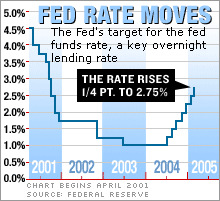 |
|
|
|
|
| More about inflation and interest rates
|
|
|
|
|
NEW YORK (CNN/Money) -
The minutes released Tuesday from the Fed's March meeting don't tell us all that much more about the central bank's thinking on inflation -- but don't tell that to Wall Street.
Stocks, which were trading lower before the minutes were released, surged higher, as investors honed in on language that indicated the Fed probably won't need to raise rates by more than a quarter point at its next meeting in May.
Bonds rallied as well. The yield on the 10-year Treasury fell from about 4.45 percent to 4.36 percent following the release of the Fed minutes. Bond yields fall when bond prices rise.
"People are breathing a sigh of relief and bought a few bonds and stocks. Everyone plays, everyone wins," said Drew Matus, senior economist with Lehman Brothers.
Matus said the market was worried that the minutes would show that Alan Greenspan and other Fed members were worried enough about inflation that they would talk about raising rates at a faster pace.
But in the minutes, the Fed said that "although the required amount of cumulative tightening may have increased...an accelerated pace of policy tightening did not appear necessary at this time...and inflation would most likely continue to be contained."
For more on the reaction in financial markets, click here. For more on the Fed minutes, click here.
"The market liked what it didn't see. The market got itself worked up about the Fed possibly being more aggressive about inflation and when that didn't appear in the minutes, investors then focused on a relatively benign view of inflation," said Matus.
Richard Yamarone, chief economist with Argus Research, agreed that the Fed is unlikely to raise rates by more than a quarter point in May, or for the rest of the year for that matter. He said the meeting minutes indicated that the major source of inflationary pressures are rising oil prices, a phenomenon that the Fed has little control over.
"There's only so much a Fed rate hike can do to thwart an inflation threat that's predominantly driven by oil prices. Raising the fed funds rate won't stop people from speculating about higher oil prices," Yamarone said.
As a result, he thinks the Fed would be making a big mistake by being more aggressive unless other types of inflation pressures picked up, such as increased wage growth.
"The Fed is going to move at its gradual, measured pace because we've hit an oil-induced soft patch," said Yamarone. "Fifty-basis-point hikes are not right when the economy is skittish and market is jittery about oil."
The Fed, the nation's central bank, has raised its short-term rate target seven times starting late last June, moving a quarter-percentage point, or 25 basis points, each time. There are 100 basis points in 1 percent.
So when all is said and done, the Fed didn't really say anything new.
Oscar Gonzalez, an economist with MFC Global Investment in Boston, said the Fed will continue to raise rates by a quarter-point at its next few meetings and that it probably won't stop until the fed funds rate, currently at 2.75 percent, reaches 4 percent. The rate is an overnight bank lending rate controlled by the Fed.
Matus and Yamarone also said a fed funds rate of about 4 percent is probably what the Fed is targeting for a so-called "neutral" level, which should be low enough to stimulate economic growth but high enough to limit inflation.
But economists warned that investors shouldn't interpret the Fed meeting minutes to mean that half-point hikes are out of the question.
"Inflation has picked up and there is some pricing power evident. Certainly by saying that, the Fed is telegraphing that they could easily increase rates by 50 basis points if they had to, even though at this point there doesn't seem to be a need for more than a quarter-point hike," said Gonzalez.
Matus agreed, noting it's more important to focus on new numbers, such as import prices for March due Friday, as well as March's consumer price index (CPI) report, due out April 20.
"If we get more inflationary data, that could bring people back to their senses. Just because the Fed talks about inflation in a benign way one meeting doesn't mean that feeling will be pervasive at the next meeting," said Matus.
At the very least, economists said, it seems clear the Fed will keep raising rates at a "measured" pace, even if it eventually gets rid of that term in its policy statements.
"It's less likely that the Fed will pause in its tightening," said Mark Zandi, chief economist with Economy.com. "A neutral rate is certainly at least 4 percent and probably a little higher. That's where we're headed."
For more on how higher rates affect you, click here.

|